
There were many striking contrasts between these two personalities. Yet they found some common chord and there began a friendship which lasted till Tagore’s death in 1941. As early as 1915, we find Tagore referring to Gandhi as ‘Mahatma’ and Gandhi readily adopted the form of addressing Tagore as ‘Gurudev’. Theirs was not a friendship based on just mutual admiration. They had differences on fundamental philosophical questions, which led to disputation about many political, social and economic matters. Pramita, a celebrated Rabindra Sangeet exponent and a Tagore scholar, revisits the interesting relationship that these two great minds had, as Special Feature, exclusively for Different Truths.
The intellectual exchange between Gandhi and Rabindranath Tagore began in 1914- 15 when Gandhi along with the students of his Phoenix School in South Africa visited Tagore’s Santiniketan. Gandhi recalled later, “It was here that members of my South African family found warm hospitality in 1914… and I too found shelter here for nearly a month.” Tagore saw, perhaps before many of his countrymen, that Gandhi promised to give an altogether new turn to the Indian struggle. We find Tagore’s first written reference to Gandhi in a letter to C.F. Andrews. Tagore wrote, “You know of our best love with you, while you were fighting our cause in South Africa alone with Mr Gandhi and others.”
In the golden jubilee number of the Indian Opinion, a piece of news published… “In a letter to Mr. Gandhi, Babu Rabindranath refers to the struggle in South Africa as the steep ascent of manhood… not through the bloody path of violence but that of dignified patience and heroic self-renunciation. The power, our fellow countrymen have shown in standing firm for their cause under severest trials, fighting unarmed against fearful odds, has given us a firmer faith in the strength of the god that can defy sufferings and defeats at the hands of the physical supremacy.”
There were many striking contrasts between these two personalities. Yet they found some common chord and there began a friendship which lasted till Tagore’s death in 1941. As early as 1915, we find Tagore referring to Gandhi as ‘Mahatma’ and Gandhi readily adopted the form of addressing Tagore as ‘Gurudev’. Theirs was not a friendship based on just mutual admiration. They had differences on fundamental philosophical questions, which led to disputation about many political, social and economic matters. Both were unsparing in their debate and neither was very successful in persuading the other towards a path of convergence of views. Each accepted cordially the other’s right to differ. These differences on public issues never affected their personal relationship.
In Gandhi’s Phoenix School in Africa, children weren’t prepared for examinations. They were given basic education, moral training – but above all an education of strict self-reliance through physical work. During his visit to Santiniketan with the Phoenix Schoolboys, Gandhi tried to instil into the boys of Tagore’s ashram, a spirit of self-reliance, to learn to do all their work themselves. With Tagore’s permission, Santiniketan students decided to do all their work themselves on 10th Match 1915. This day is observed as ‘Gandhi Punnyaha’ even today.
Let us go through a portion of a letter to Gandhi sent by Tagore and also communicated to the press from Santiniketan on 12 April 1919 on the eve of the Jallianwala Bagh massacre:
Dear Mahatmaji,
Power in all its forms is irrational, it is like the horse that drags the carriage blindfolded. The moral element in it is only represented in the man who drives the horse…
I know your teaching is to fight against evil by the help of the good. But such a fight is for heroes and not for men led by impulses of the moment. Evil on one side naturally begets evil on the other, injustices leading to violence and insult to vengefulness. Unfortunately, such a force has already been started and either through panic or through wrath, our authorities have shown us their claws whose sure effect is to drive some of us into the secret path of resentment and others into utter demoralisation…”
The very next day, on 13 April 1919, the Jallianwala Bagh massacre by General Dyer and his soldiers took place. Tagore renounced his knighthood on 29th May and Gandhi wrote to the viceroy surrendering Kaiser- I- Hind gold medal and Boer War Medal in 1st August 1920.
Gandhi’s idea of non-cooperation, boycotting government schools, giving up foreign clothes did not altogether satisfy Tagore who felt frenzied agitation was not long-lasting, but his call catapulted Gandhi to the leadership of this mass movement.
After the meeting of the two men, in September 1920, in Santiniketan, Tagore and Gandhi met in Jorasanko on 6th September 1921. Both of them talked about the ways to attain independence. While Gandhi wanted to gain independence for the country, Tagore wanted freedom of human minds first, which he thought would bring freedom for the country.
In 1925, Gandhi came to Santiniketan. Gurudev and Gandhi talked about Charkha, the spinning wheel. Gurudev was against this but then again their everlasting mutual respect did not wane; when on 4th January 1932 Gandhi was arrested and kept in the Yerwada prison in Pune, Tagore wrote to Ramsey McDonald strongly condemning his act of repression. On 20th September 1932 news reached Santiniketan that Gandhi will start an indefinite fast. Gurudev went all the way to Pune and a letter came from England that a new constitution would be passed and there would be a reconciliation with the depressed classes. Gandhi embraced Tagore and drank some juice. He asked Gurudev to sing his song: ‘Jibono Jokhono Shukaye’.
In 1934, Gandhi came to Bengal and his meetings were to be boycotted by many. Rabindranath wrote, “I have often disagreed with him and even quite recently criticised his belief b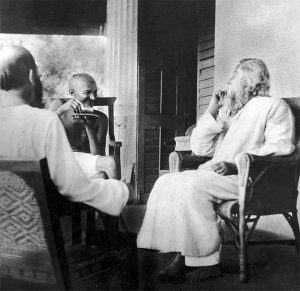 ut I have enough regard for the sincerity of his religious convictions and abiding love for the poor.”
ut I have enough regard for the sincerity of his religious convictions and abiding love for the poor.”
In one of his lectures Tagore had said, “This man has neither physical nor material power but his humanity reveals itself in its simple majesty and invokes within us a strong assurance of Man the indomitable and the people downtrodden for centuries, their backs bent down under loads of indignity suddenly stand up, ready to suffer, and through suffering conquer.”
Gandhi gave Gurudev a cheque for Rs. 60,000 for his Santiniketan to relieve him from his strenuous fundraising tours. Both of them felt very strongly about untouchability and casteism. Gurudev wrote, “All manner of humiliation and disabilities from which any class in India suffers should be removed by heroic efforts and self- sacrifice.” On 17th February 1940, Gandhi and Kasturba came to Santiniketan together. Tagore garlanded him and said, “We accept you as our own, as one belonging to all humanity.” Gandhi in reply said that from the beginning he had felt Gurudev’s love and his heart was full of the poet’s blessings. This was the bond between the Great Teacher, Gurudev and the Great Soul, Mahatma.
Photos from the Internet
#TagoreAndGandhi #TheMahatma #GandhiInShantiniketan #GandhiAndKasturba #TributeToTagore #DifferentTruths

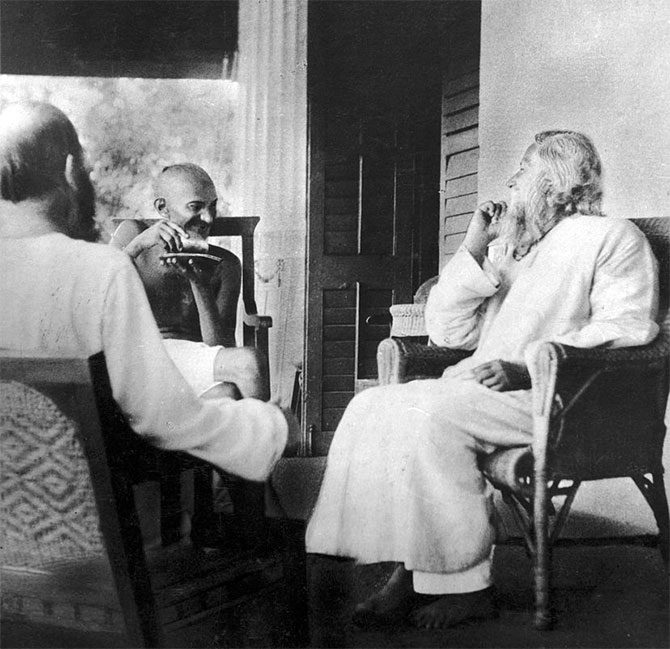
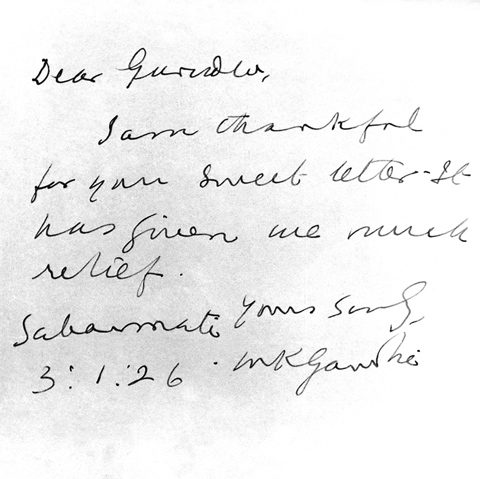
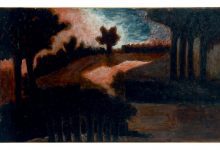
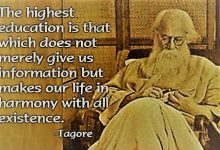

 By
By
 By
By
